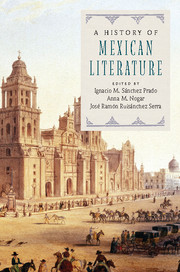Book contents
- Frontmatter
- Contents
- List of contributors
- Introduction
- PART I COLONIAL LITERATURE
- 1 The Languages and Literatures of Early Print Culture in the Colonia
- 2 A Chronicon of Crónicas: The New Spanish Prose Narrative
- 3 Theatricality and the Public Enactment of the Mexican Colonial
- 4 Sor Juana Inés de la Cruz: The Tenth Muse and the Difficult Freedom to Be
- 5 Jesuit Enlightenment: Interventions in Christianity and Intellectualism
- 6 Women in the Print Culture of New Spain
- 7 The Colonial Literary Scope: Empire, Letter, and Power
- 8 New Spain's Archival Past and Present Materiality
- PART II THE NINETEENTH CENTURY
- PART III TWENTIETH AND TWENTY-FIRST CENTURIES
- PART IV MEXICAN LITERATURE BEYOND BOUNDARIES
- Index
- References
8 - New Spain's Archival Past and Present Materiality
from PART I - COLONIAL LITERATURE
Published online by Cambridge University Press: 05 July 2016
- Frontmatter
- Contents
- List of contributors
- Introduction
- PART I COLONIAL LITERATURE
- 1 The Languages and Literatures of Early Print Culture in the Colonia
- 2 A Chronicon of Crónicas: The New Spanish Prose Narrative
- 3 Theatricality and the Public Enactment of the Mexican Colonial
- 4 Sor Juana Inés de la Cruz: The Tenth Muse and the Difficult Freedom to Be
- 5 Jesuit Enlightenment: Interventions in Christianity and Intellectualism
- 6 Women in the Print Culture of New Spain
- 7 The Colonial Literary Scope: Empire, Letter, and Power
- 8 New Spain's Archival Past and Present Materiality
- PART II THE NINETEENTH CENTURY
- PART III TWENTIETH AND TWENTY-FIRST CENTURIES
- PART IV MEXICAN LITERATURE BEYOND BOUNDARIES
- Index
- References
Summary
Mientras más la leía [a sor María], más la creía arraigada en la realidad del México colonial. Tanto, que ni por un solo momento la sospeché ajena.
—Rima de Valbona, “El legado de la Venerable María de Jesús de Agreda”As we have seen in the innovative essays treating pre-Columbian and colonial-era literature in this book, answering the questions of what comprises text; who its producers were; and how to understand authorship, readership, and literacy in the colonial period continues to call for new and creative approaches. The cross-pollination of contextualized history (specifically that of individuals marginalized in colonial society) with sophisticated investigations into how agency was covertly and overtly asserted, combined with a reconsideration of the advancement and obstruction of textual production and circulation, has produced new lenses through which to interpret literature from the Mexican colonial period. The essays in this section of the book dynamically advance scholarship treating indigenous intellectual culture and textuality (Heather Allen, Santa Arias, Anna More); expand narrow or categorical views of key critical ideas (Patricia Ybarra, Ivonne del Valle); and reflect on women's historically unappreciated activity in learned circles (Mariselle Meléndez, Catherine Boyle).
In contrast to the idea that alternative literary or paraliterary readings of colonial-era writing result in a depoliticized understanding of a body of literature, the approach to the archive implemented in this essay accomplishes the opposite. By reading what could be considered a literary archive outside of the primary texts themselves (that is, the contents of the writing), the extent and shape of the community of reading for those texts emerges. The understanding and reading of literature has broadened to include quantitative approaches to reading and texts (Moretti, 2013), varying depths of reading and textual analysis (Love, 2013; Best and Marcus, 2009), considerations of the history of readers and reception, and historiographical/bibliographical approaches to print media specific to colonial Latin American letters (Leonard, 1992; Calvo, 2003; Chocano Mena, 1997). The method outlined here illustrates the reach and impact of writers who have not been seriously considered by critics, whether through their literary texts or in terms of the cultural influence they wielded.
This lateral approach avoids charging straight at the literary archive to examine the texts themselves; instead, it implements materials from various collections to define the scope and nature of reading, using, in effect, the archival past to define a writer or text's materiality.
- Type
- Chapter
- Information
- A History of Mexican Literature , pp. 128 - 140Publisher: Cambridge University PressPrint publication year: 2016

